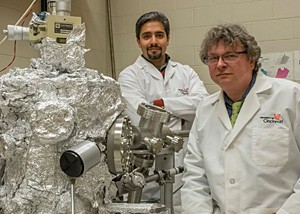
UC Researchers Tackle the Tiniest Technology to Make Gadgets Smaller, Faster and More Efficient
University of Cincinnati researchers are discovering how to manipulate light to one day better view the worlds tiniest objects through a super-lens, as well as how to hide an object in plain sight.
Masoud Kaveh-Baghbadorani, a doctoral student in the University of Cincinnatis physics program, will present this research on March 4, at the American Physical Society Meeting in Denver.
The research focuses on exciting collective oscillations of metal electrons called plasmons, and on directing light through nanometer-thin metal films, about a thousand times thinner than a human hair. The result could empower integrated circuits or facilitate a super-lens with seven times the strength of a standard microscope, opening further research into fields such as studying microorganisms and viruses.
Other applications involve bouncing light around an object by cloaking it with a metamaterial film. Instead of the object reflecting light and thus causing it to be seen, the light manipulation can make it invisible.

lab
Plasmonics is an emerging field, but it has its limitations due to the loss of energy in the metal layers, which dissipate the plasmon energy into heat. Kaveh-Baghbadoranis research focuses on developing hybrid metal/organic nanowires that essentially work as an energy pump to compensate for metal losses in plasmonic nanostructures.
This energy pump results from exciton radiation, an electronic excitement in the semiconductor nanowires. Kaveh-Baghbadorani explains that the exciton functions somewhat like a hydrogen atom negative and positive charges are bound together. The research is examining energy transfer from excitons in semiconductor nanowires to different metal materials used to cover the nanowires, as well as the effects of the thickness of covering organic layers in energy transfer.
The researchers want to know how the dynamics of excitons are affected by the use of different organic materials, and how lifetime and energy transferring processes of nanowire excitons are modified by changing the design of the nanowires or the thickness of organic spacer layers.
Kaveh-Baghbadoranis advisor, Hans-Peter Wagner, a UC associate professor of physics, is one of the co-researchers on the project. To achieve our goal, the knowledge of exciton relaxation and energy-transfer processes in plasmonic semiconductor nanowire heterostructures is of crucial importance, says Wagner, whose lab has a growth facility to allow researchers to produce a variety of plasmonic structures. The lab also has special optical methods to measure exciton relaxation processes on a sub-picosecond time-scale.

Masoud Kaveh-Baghbadorani
Co-researchers on the project include Wagner; Qiang Gao, research fellow, and Chennupati Jagadish, professor of engineering, Australian National University, where the semiconductor nanowires are produced; and Gerd Duscher, professor of engineering, University of Tennessee.
The
American Physical Society meeting
is the largest meeting of its kind in the world, and focuses on research from industry, universities and major labs. The meeting brings together nearly 10,000 physicists and students to share their groundbreaking research.
The University of Cincinnati was the first institution west of the Appalachian Mountains to offer a PhD in Physics.
Related Stories
New Dungeons & Dragons ethics seminar takes flight
July 7, 2025
On a blisteringly hot summer day, laughter echoed through the cool, damp basement of the Avondale branch of the Cincinnati Public Library. Young teenagers huddled around a table littered with pencils and paper, rolling dice and bonding over a game of Dungeons & Dragons. University of Cincinnati undergraduate student Charitha Anamala sat behind a trifold card with a blazing red dragon on it, serving as the group’s Dungeon Master (DM) or campaign organizer. Within the fantasy setting she described, it was hard to tell the adventure was a lesson in ethics.
UC language studies program adopts new technologies
July 7, 2025
Cultural immersion is a tried-and-true method for teaching languages. U.S. students travel abroad—to Europe, Latin America, Asia and beyond to take a deep dive into the customs, mores, daily life and conversational language that can be challenging to master from home. For those students who can't take advantage of the study-abroad experience, there's another option to gain the same learnings. At UC, the Curricular Enhancement, Development, Access and Research Language Resource Center (CEDAR) has developed a curriculum that features virtual reality (VR) technology to give students a similar opportunity right in the classroom.
Distinguished UC professor receives career achievement...
July 3, 2025
The College of Arts and Sciences Research Professor Gail Fairhurst was awarded an International Communications Association (ICA) Career Achievement Award. The Steve Chaffee Career Achievement Award goes to theoretical development or research related to communication studies. The ICA created the award in 2000 for its namesake, Steven H. Chaffee, who was a trailblazing scholar in journalism and communications academia.
